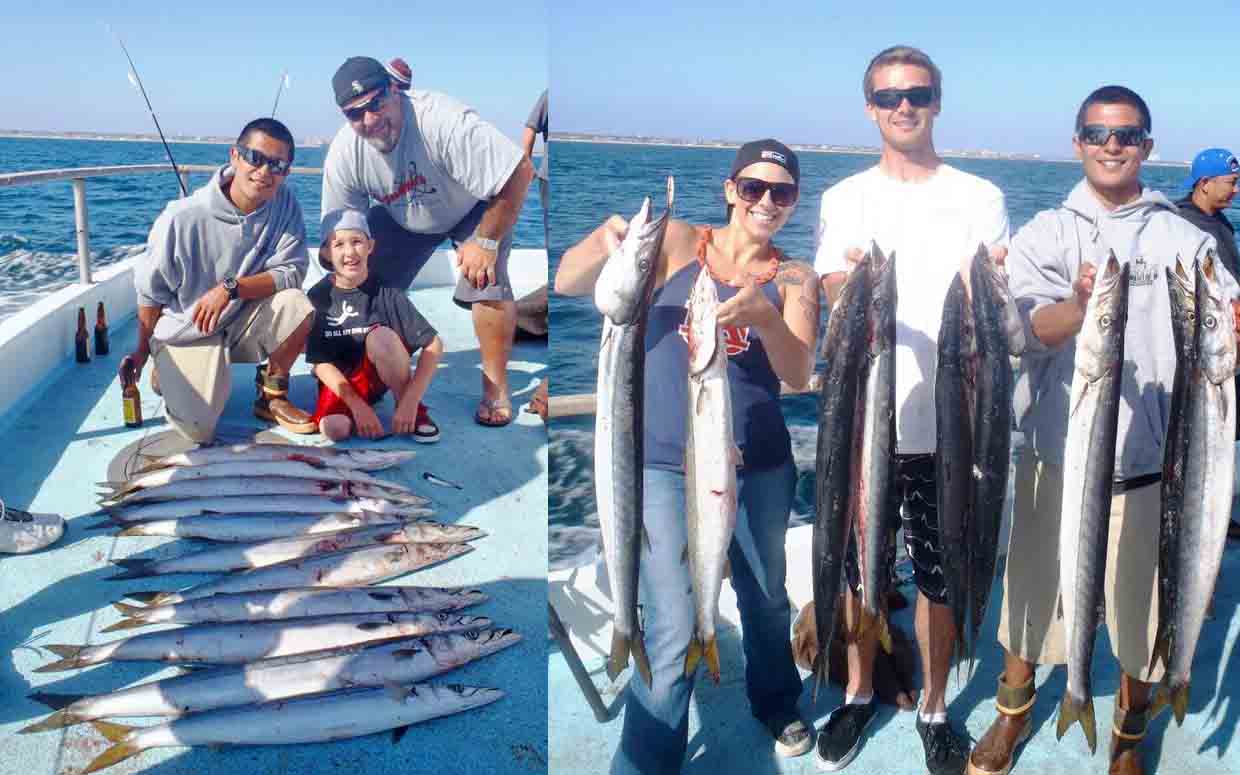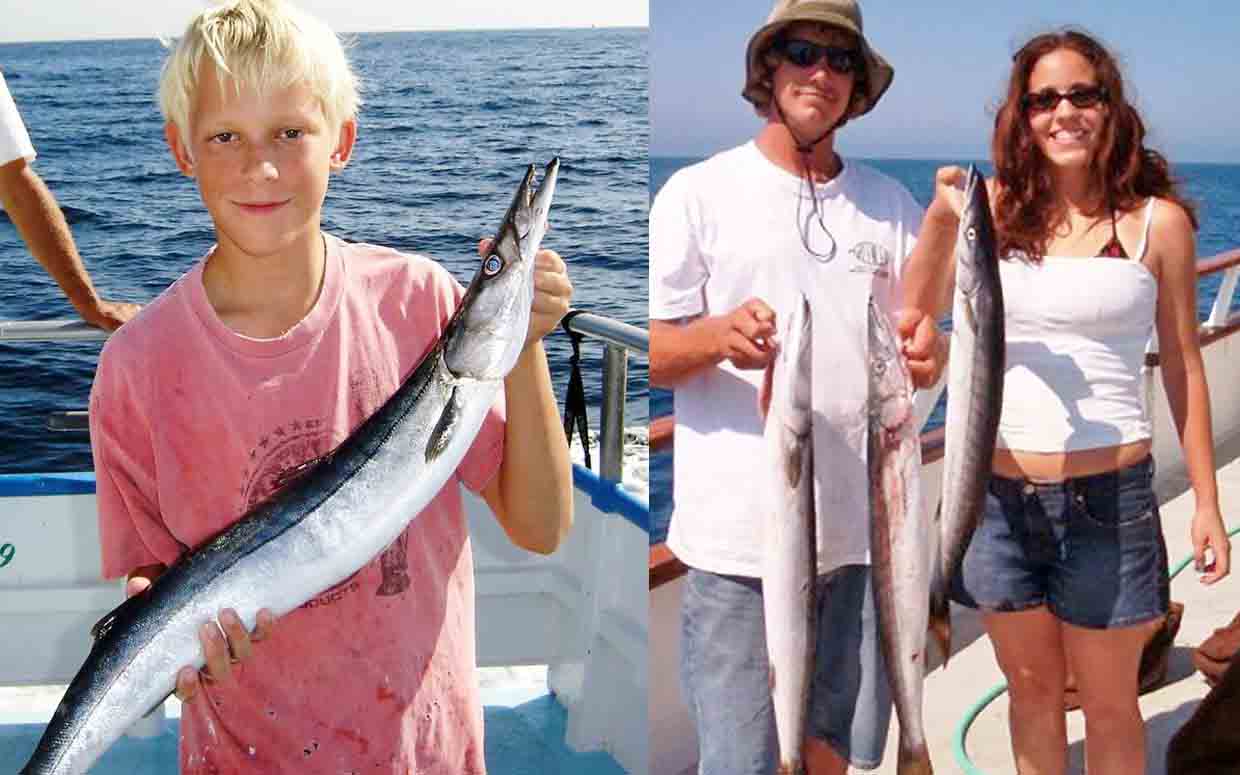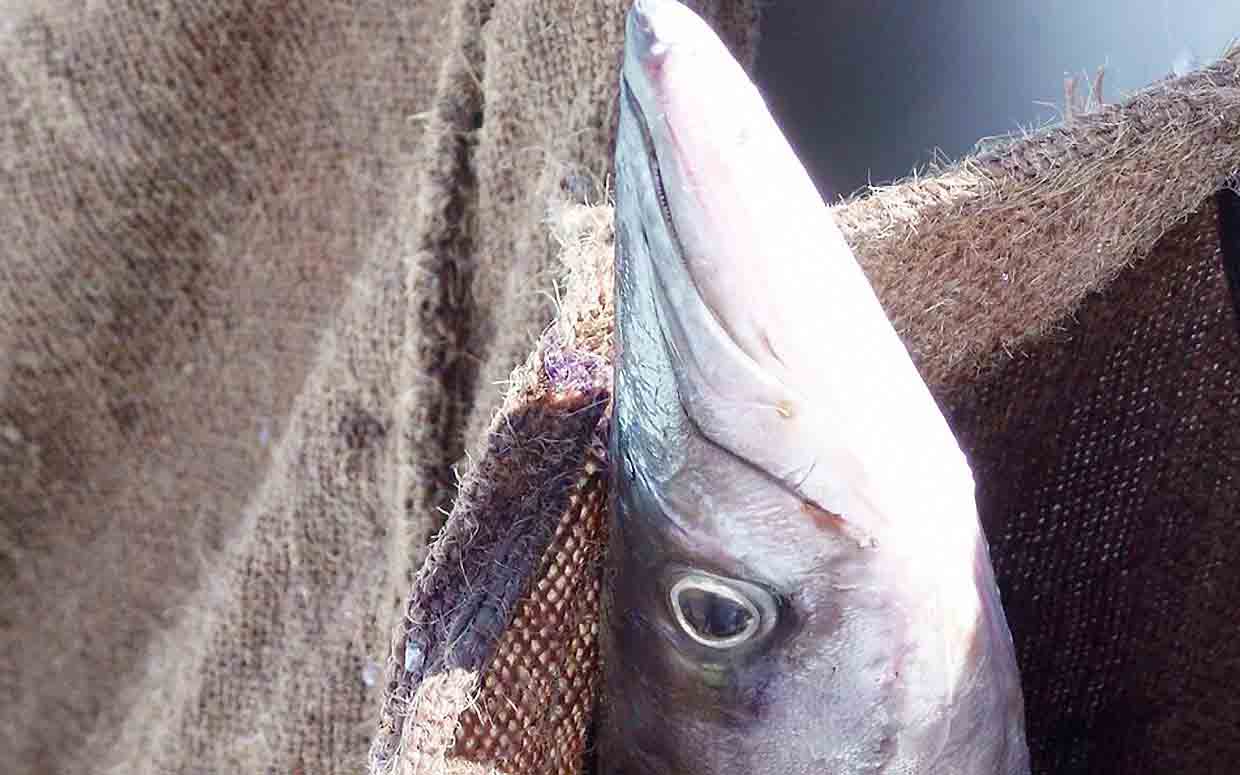Barracuda Fishing
Barracuda Fishing in Southern California - Techniques & Seasons

Barracuda fishing can be fast and furious action with fish boiling all around the boat and biting almost anything that hits the water. Barracuda can be a challenge to land with mouth full of sharp teeth and sharp runs. Barracuda usually show up in southern California Ocean waters in April with Catalina Island usually the first location to have huge numbers go on their annual spring bite. Locations all along our coastline follow shortly there after with large schools of barracuda feeding aggressively all along our coast. Late spring sees the largest number of barracuda as do the summer months when barracuda and sand bass get mixed together creating some super exciting fishing action. Fall can still find barracuda present, but usually in smaller numbers than the spring and summer months and less concentrated. Winter finds most of the coastal barracuda action to have disappeared with Catalina Island and San Clemente Island still producing fair to good numbers at times.
Spring Barracuda Fishing
Spring barracuda fishing has large schools of barracuda moving into our waters following large schools of bait fish and warmer waters. These large schools move around quite a bit from one location to another for the first few weeks.Usually the largest barracuda of the year are caught at this time. Iron jigs are the preferred technique for catching these spring barracuda as their mouths have very sharp teeth that will bite through mono when using a straight mono to hook connection. Iron jigs vary in weights, sizes, and colors. Popular colors are blue and white, green and yellow, and chrome and blue. The thought is that on brighter days brighter colors and on overcast days duller colors, but it seems that the colors that match the majority of the bait in the area seems to be the best indicator for preferred color for barracuda fishing. It is always good to have several color variations as you never know which may be the hot color and it pays to rotate until you find a combination that works the best. Along with selecting which color to use when jig fishing, the weight of the jig is very important. When barracuda schools are below the surface, rarely seen boiling, a deeper running or heavier jig would be the best choice. While when the barracuda are all over the surface, a surface iron may get more action. If the barracuda are a little finicky a surface iron can get them to bite as it has more action than its deeper running counterparts. Also when fishing all iron jigs letting them sink to varying depths and then retrieving changes the presentation and area of the water column fished and can be very effective. Once you have selected the color and weight selecting the size of your iron jig is equally important. With barracuda schools of varying sized fish, a larger jig will reduce the by catch of undersized fish and result in more trophy sized barracuda. By the same token smaller jigs may attract bites when bait fish are running smaller or when barracuda become a little touchy while on the bite. Having a good selection on iron jigs will address almost all barracuda requirements for spring. Along with iron jigs, fly lined and weighted bait offerings and wire leader offerings are very effective. With the straight mono you stand the best chance of getting barracuda to bite, but have the least chance of landing these toothy fish. Losing 75% or more is the norm. Add a wire leader and your catch rate increases dramatically but the number of bites may suffer.
The key is to know when you can use a wire leader and when you can’t. When barracuda are biting jigs at pretty good clip, bait with a wire leader will be effective. When barracuda are boiling around the boat, but not biting the jigs very effectively the use of a wire leader would prove unwise. The more aggressive that the barracuda are the higher likelihood that a wire leader will work well. When fishing a wire leader you can use no weight or a light sliding sinker from ¼ ounce to maybe ½ ounce or a torpedo weight set up. When fishing the torpedo rig, stop the decent at different depths as many times barracuda will strike at these different stops. The torpedo rig is great for beginners as casting is not necessary and it is fairly easy to stay in contact with the bait. As a rule the deeper you go when fishing a barracuda school, the larger the barracuda. This does not always hold true, but generally so in the spring months. Below are some helpful tips for hooking your bait and the fly lining technique:
- When fishing with fin baits it is very important to select healthy bait and as carefully as possible hook your bait either in the nose sideways, collar area, or even belly area depending on how you want your bait to swim. Hooking the bait through the nose sideways will cause your bite to swim slightly side wards and at angle to the boat. Hooking it in the collar will also cause the bait to swim sideways as well as slightly downward. Hooking the bait in the belly will cause the bait to swim downward and away from the boat (use when wanting to have your bait go deep). If you are unsure on how you want to present your bait, hook it threw the nose sideways as this will be the easiest and best for the longevity of your bait.
- Once you have cast your fin bait try to let it swim as natural as possible this means letting it take line out and not pulling on it or creating resistance against the bait. If your bait is staying put and not moving much you can give it a twitch to wake it up. If that doesn’t liven up your bait, then it is time to change your bait. Change your bait almost every cast. This is very important as strong bait will get the most bites on barracuda and almost all other game fish. The only time this doesn’t apply is if you have limited bait or a limited type of bait. In this case try to make the most out of every bait you have.
Summer Barracuda Fishing
Summer barracuda fishing is a continuation of the spring with non stop action. The difference is that schools of barracuda stay in relatively the same areas for a much longer period of time. The result can be non stop action that continues for a long time. This often occurs when fishing sand bass, as huge barracuda schools will also be present and result in a fish traffic jam with non stop action. Techniques for fishing summer barracuda do not differ much from the spring months except larger barracuda are usually found closer to the surface and bait fishing is the primary technique for consistently catching these fish and summer barracuda in general. This usually means without a wire leader and is quite challenging.
When using just mono to hook for barracuda the key is to strike at the first sign of a bite. Barracuda bite so aggressively that by the time you feel the bite it is often too late and barracuda has taken both bait and hook so watching your line as you fly line bait for in sudden jumps is very important. Striking immediately and keeping constant tension while fighting the barracuda ensures the hook does not pop out resulting in much higher catch rates
- Longer shank hooks can also provide some benefits that are similar to wire leaders, but without the decrease in bites. Using very lively bait is very important especially on touchy bites.
Here are some helpful tips for the standard tuna fishing options:
Surface iron is extremely effective on barracuda during the summer as they are a little bit more sluggish than in the spring. Early in the morning and late in the afternoon are the hot bite times for those fishing surface iron.Try letting your surface iron sink out quite a bit and then retrieve this gives you the action that a surface iron has but covers deeper water zones. Plastics can also be very effective with better catch rates than a bare hook, but much lower than an iron jig. The downside with plastics is one bite from a barracuda usually means the demise of that plastic. Also due to the short hook length you can go through lots of plastics and lead heads in short order
- The upside is you can fish for sand bass and barracuda and not be dependent on going to the bait tank with every bite. Twilight trips (late afternoon and evening fishing trips) during this time of year get in amazing bites on barracuda before and after dark. Barracuda are one of the primary game fish caught on local ½ day and ¾ day trips and are very hard fighters with most anglers using 20 pound test to target these fish. Barracuda are also considered good eating when prepared fresh after catching or smoked.
Fall Barracuda Fishing
Fall fishing for barracuda takes a back seat to all of the larger game fish usually present. There still is a healthy number of barracuda to target at this time of year though with schools of barracuda around reefs and other structures both coastally and at the islands. Bait fishing with no wire leader is the primary method. Often yellowtail and White Sea Bass will be found mixed in with the barracuda at this time of year and retying your hook constantly is very important to avoid loosing one of these larger game fish. A lead head can also work well with the longer shank benefits of landing more fish while still presenting the bait in a natural manner. Barracuda become more sluggish in feeding and the balance between waiting long enough for them to have taken the bait and too long resulting in a bite off is challenging. The islands also produce good scores on barracuda during this time often mixed in with bonito and yellowtail. Surface iron may prove quite effective especially for getting the larger barracuda and other game fish at the islands. Usually a larger offering, the surface iron keeps the undersized and smaller game fish from disrupting the presentation for larger game fish. When fishing for barracuda with bait keep your drag slightly lighter than you would otherwise have it. Especially if you are using light line of 15 pound test or lighter. Using this lighter drag setting will result in less break offs from sudden runs and also reduce the number of hooks pulling loose.
A Few Other Suggestions/Recommendations for Targeting Barracuda
Typically the lighter the line the more bites you will get from barracuda, but it will also result in less fish landed. Knowing the balance is key. Also when bringing a barracuda to the boat you have the option of calling for gaff or trying to bounce or lift the fish over. When calling for a gaff you can help by laying the fish out for a clear gaff shot. This entails pulling the fish parallel to the boat to offer the largest surface area for the gaff to hit its mark. For bouncing barracuda 20 pound test line or greater is needed and care in lifting the barracuda into the boat without putting others at risk of injury is necessary. Bouncing the barracuda by lifting in a quick manner from the surface of the water to about 2 feet up and then backing off the motion to create an arc bring the barracuda just into the boat in a area you have selected to minimize injury for others. As the barracuda is airborne put the spool out of gear so if the jig comes free it will not spring with the tension of the line when the barracuda comes back down to earth in the boat sending jig or hook flying. Barracuda are one of the best game fish for those new to sportfishing to encounter with blistering runs and aggressive feeding habits. These fish rarely disappoint.










